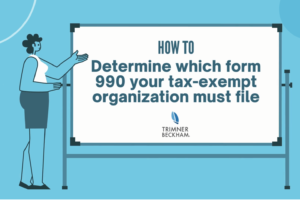Noncharitable nonprofits include all tax-exempt organizations that are not charities: trade associations, social welfare organizations, labor unions, fraternal organizations, title-holding companies, VEBAs, and a variety of others. Whereas a public charity, which is classified under Internal Revenue Code Section 501(c)(3), is forbidden from engaging in politics and is limited in the amount of lobbying it can do, a noncharitable tax-exempt organization may engage in political activity and unlimited lobbying.
Lobbying
Generally, lobbying is a communication designed to influence the passage or defeat of a piece of legislation:
- Bills, acts, resolutions, Constitutional amendments, and similar items being considered by a legislative body at the federal, state, or local level,
- US Senate confirmation of treaties and of nominees to the executive or judicial branches,
- Ballot initiatives, referendums, and petitions where the general public acts as the legislative body, and
- Communications with covered executive branch officials (CEBOs) regarding executive orders, administrative rules, court opinions, agency decisions, and actions by nongovernmental organizations. CEBOs include:
- The President of the United States
- The Vice President of the United States
- Cabinet Secretaries and immediate deputies
- Any officer or employee of the White House Executive Office
- The two most senior officials at all Executive agencies
- Level I individuals of the Executive Schedule and immediate deputies
What is the Difference Between Direct and Grassroots Lobbying?
Grassroots lobbying is a call to action that attempts to motivate the public to contact legislators to support or oppose a specific piece of legislation.
Direct lobbying involves contacting a member of a federal, state, or local legislative branch in an attempt to affect the passage or defeat of legislation. Note that an attempt to influence the public’s support or opposition to a referendum or ballot initiative is classified as direct lobbying since the organization is attempting to influence the public where the public is acting as a legislative body.
What is Not Lobbying?
- Communications with members. A tax-exempt organization is permitted to communicate with its members regarding the organization’s position on the legislation. Such communication is not considered lobbying; it is merely an internal conversation within the organization. If the tax-exempt organization encourages its members to contact legislators to support or oppose the legislation, that is direct lobbying since it is as if the organization itself is directly contacting the legislators. Generally, members include all paid and volunteer staff, agents, and officers; all members of the governing body and its committees; members of the organization’s chapters; and anyone who contributes more than a nominal amount of time or money to the organization. Internal communications can support or oppose legislation without being classified as lobbying as long as there is no call to action (encouraging members to engage themselves in direct or grassroots lobbying).
- Nonpartisan analysis, study, or research. The communication must provide a full and fair explanation of the issues so the reader can form an independent conclusion, and it must be widely disseminated to interested persons, not just to those who agree with the organization’s viewpoint. The communication must not include a call to action in support or opposition to the legislation.
- Examination of broad social or economic problems. Communicating with legislators, the public, and other interested parties on topics that are the subject of legislation is not lobbying as long as the communication does not refer to a specific piece of legislation and does not include a call to action.
- Requested technical advice. Communicating in response to a written request by a legislative body or legislative committee is not lobbying if the communication is provided to all members of the requesting entity. The request cannot come from a particular legislator acting alone.
- Self-defense. Communication with a legislative body regarding actions that would threaten the organization’s existence or tax-exempt status is not lobbying as long as the communication does not include a call to action.
How much lobbying can a noncharitable tax-exempt organization do?
There is no limit. For example, a tax-exempt 501(c)(6) organization is operated primarily to promote a common business interest and to better the business conditions of one or more lines of business, even if its sole activity is directed to the influencing of legislation which is germane to such common business interest. In some situations, the objectives of the organization can only be attained through the legislative process. For a 501(c)(4) organization, lobbying may be the actual mission. 501(c)(3) public charities often create a social welfare organization to use to engage in unlimited lobbying.
Reporting Lobbying on Form 990
Although member dues to a noncharitable tax-exempt organization may be deductible as an ordinary and necessary business expense, lobbying activities are not deductible. Therefore, the organization must inform members that they may not deduct the portion of the dues that the organization spends on lobbying. It does not matter if the organization has other sources of revenue from which to draw; it is assumed that the lobbying expenditures are entirely made from the membership dues revenue.
When membership dues are assessed, the tax-exempt organization must estimate the portion of the dues that will be nondeductible because the organization will make lobbying expenditures during the year. Then at the end of the year, the organization determines the actual lobbying expenditures incurred and compares that to the estimated lobbying activity from the dues invoices. A modest deficit may be carried over to the subsequent year.
Example: The nonprofit estimates that 15% of membership dues will be nondeductible as lobbying expenditures and notifies members on the dues invoice at the beginning of the year. At the end of the year, the organization has membership dues revenue of $1,000,000 and actual lobbying expenditures of $170,000 (17% rather than 15%). Therefore, the organization has allowed its members to deduct, in the aggregate, 2%, or $20,000, more than they are entitled to deduct. The organization may carry the deficit forward and include it in the calculation for the subsequent year. If it anticipates that the lobbying activity will again be approximately 17% of total dues revenue, then it may wish to notify members in the subsequent year that 19% is nondeductible in order to cover the previous year’s deficit.
Alternatively, the nonprofit organization may choose to pay the tax on behalf of its members, called a “proxy tax.” The tax rate is 21%, no deductions are permitted, and estimated payments are not required. The organization calculates the difference between the estimate it provided to its members, which in some cases is 0%, and the actual lobbying expenditures and reports the deficit on Form 990-T instead of carrying it over to the subsequent year.
There are two situations where a nonprofit organization is not required to notify its members that a portion of the membership dues is nondeductible:
- The organization spent less than $2,000 on in-house lobbying (no expenditures on outside lobbyists), or
- At least 90% of the members can’t deduct the dues as a business expense (for example, when the members are individuals who can’t deduct the dues as a business expense).
Calculating Lobbying Expenditures
The tax-exempt organization must retain documentation of all lobbying activities and communications. Timesheets and cost logs should support the calculation, including the cost of research, drafting, reviewing, copying, printing, publishing, and distributing the communication. Care must be used to differentiate member communications from non-member communications, and mixed-purpose communications (such as a fundraising appeal that also includes a call to action) must be segregated.
The nonprofit must use a reasonable and consistent method for allocating overhead to its lobbying activities. The IRS has identified specific pre-approved methods for determining lobbying expenses:
- Gross-up method
- Determine the salary expense (excluding benefits) for lobbying personnel, clerical, and support activities
- Multiply by 175%
- Add direct non-personnel expenses such as travel, entertainment, and outside lobbyists.
- Alternative Gross-up method
- Determine the salary expense (excluding benefits) for lobbying personnel only
- Multiply by 225%
- Add direct non-personnel expenses such as travel, entertainment, and outside lobbyists.
- Ratio Method
- Determine hours for lobbying activities as a percentage of hours for all activities
- Multiply by total expenses (excluding outside lobbyists)
- Add outside lobbyists.
- IRC 263A Method: Treat lobbying as a separate service department or function.
- De Minimis Rule: If an individual has no direct contact with legislators and spends less than 5% of his or her time on lobbying activities, then that person may be excluded from the tax-exempt organization’s calculation.
Political Campaign Intervention
What is Political Activity?
Generally, political activity is a communication designed to influence the election or defeat of a candidate for political office, including:
- Contributions to political campaign funds,
- Public statements made on behalf of an organization in support or opposition to a candidate,
- Distribution of information that supports or opposes a candidate, and
- Partisan voter education and registration efforts that support one candidate’s position over another.
What is Not Political Activity?
- Candidate appearances and debates. Incumbent officials may appear at a nonprofit organization’s event in their official capacity. For example, inviting the mayor to deliver a non-election speech to a nonprofit organization is not a political activity. However, during an election campaign, all candidates must be given an equal opportunity to speak. Questions must be balanced and nonpartisan, and the organization may not make comments regarding the questions and answers provided by the candidates. Candidates must not ask for contributions.
- Nonpartisan voter education and registration. Voter registration booths that promote the election but do not mention either candidate or party, telephone banks that contact all registered voters without encouraging or discouraging support for either candidate or party, and voter guides that provide a fair and balanced explanation on a wide variety of issues are not political activities of a nonprofit organization.
How much political activity can a noncharitable tax-exempt organization do?
The political activity must not become the tax-exempt organization’s primary purpose. The most aggressive interpretation would conclude that no more than 49.9% of the organization’s activities can be political, while a more conservative view would be that the political activity must not be the largest activity undertaken by the organization.
Reporting Political Activity on Form 990
All expenditures for political activity, including amounts paid to a 527 organization (a political action committee or PAC), must be reported on Form 990 Schedule C Part I. In addition, the organization must file Form 1120-POL and pay income tax on the lesser of its:
- Aggregate political expenditures (direct and indirect), or
- Net investment income (interest, dividends, royalties, rents, capital gains, less direct investment expenses)
Effectively the nonprofit organization is not permitted to treat investment income as tax-exempt to the extent that such income was spent on political activity. The tax rate is 21%. Form 1120-POL has a $100 specific deduction, so an organization with less than $100 of either investment income or political expenditures is not required to file Form 1120-POL.
Calculating Political Expenditures
The tax-exempt organization must use a reasonable and consistent method for allocating overhead to its political activities. The IRS has identified the same pre-approved methods for determining political expenses as those described above under “Calculating Lobbying Expenditures.”
What is a PAC?
Organizations described in IRC 527 have political activity as their primary exempt purpose:
- Political Action Committees are tax-exempt organizations that are organized and operated primarily for accepting contributions or making expenditures to candidates or to influence the election of any individual to a public office (independent expenditures). They are tax-exempt only on “exempt function income” (contributions, membership dues, proceeds from a political fundraising or entertainment event, proceeds from the sale of political campaign materials not received in the ordinary course of a trade or business, and proceeds from bingo to the extent such amounts are used to influence an election). Other income, including investment income, is taxable to such organizations.
- Separately segregated funds (SSF) are separate and distinct accounts within the noncharitable tax-exempt organization. The SSF must have its own employer identification number (EIN) and must hold all assets in separate bank accounts using that EIN. The organization may accept political contributions earmarked for the SSF, and no political activity will be attributed to the organization if it “promptly and directly delivers” the contributions to the SSF’s account. Any nonpolitical activity of the SSF may be taxable.
For more information, please reach out to us for a free initial consultation.




